In the digital age, bombarding users with generic content no longer cuts it. With the immense volume of information available at their fingertips, consumers now expect tailored experiences that cater directly to their unique interests and preferences. So, how can businesses rise to meet these expectations? The answer lies in harnessing the power of Artificial Intelligence (AI). As the modern cornerstone of personalized content, AI doesn’t just change the game; it revolutionizes it.
This guide aims to provide a deep dive into the intertwining realms of AI and content personalization, equipping business leaders with the insights needed to stay ahead in a world increasingly defined by customization.

Understanding Content Personalization
Content personalization is the strategy of tailoring content to the individual preferences, behaviors, and needs of users. This goes beyond just addressing a customer by their first name in an email. It’s about delivering relevant content based on an individual’s previous interactions, browsing history, location, and even mood.
When users feel that content speaks directly to them, they’re more likely to engage. A study suggests that personalized web experiences can increase sales by up to 20%. Furthermore, with the saturated digital landscape, personalization acts as a differentiator, helping brands stand out in a sea of generic content.
The Difference Between General Content Strategies and Personalized Approaches
General content strategies often rely on a one-size-fits-all approach, casting a wide net in hopes of catching as many users as possible. This broad approach, while useful in some scenarios, often lacks the nuance and specificity needed to captivate individual users.
On the other hand, personalized content zeroes in on an individual user’s traits and behaviors. It could be as simple as offering product recommendations based on past purchases or as intricate as tailoring a website’s entire user interface to suit one’s browsing habits.
Benefits of Personalized Content for Businesses and Users
For Businesses:
- Increased Engagement: Personalized content resonates more, leading to higher click-through rates and longer dwell times.
- Boosted Conversions: Relevant product recommendations or tailored ad campaigns result in higher conversion rates.
- Enhanced Loyalty: Users appreciate brands that “understand” them, leading to increased brand loyalty.
For Users:
- Relevant Interactions: No more sifting through irrelevant content. Users get straight to the content that matters to them.
- Seamless User Experience: Personalization can lead to smoother navigation and a more intuitive user journey.
- Time Efficiency: Users spend less time searching for what they need and more time consuming what they like.
Basics of AI and Its Relevance in Personalization
Artificial Intelligence encompasses a wide array of technologies, including machine learning (ML), neural networks, and natural language processing (NLP). But what makes AI special isn’t just its ability to calculate vast amounts of data rapidly; it’s its capacity to learn from this data, adapt, and make predictive decisions.
For business leaders, it’s essential to grasp AI’s transformative power. In the context of content, AI isn’t just a tool to streamline processes; it’s a sophisticated ally that can identify patterns, make data-driven recommendations, and personalize user experiences on an unparalleled scale.
AI’s Role in Content Creation, Curation, and Delivery
The convergence of AI and content yields a symphony of possibilities:
- Content Creation: AI tools like GPT-4 (a language generation tool) can craft content, from news articles to marketing copy, that’s coherent and contextually relevant.
- Content Curation: By analyzing user behavior and preferences, AI can curate personalized content libraries, ensuring users always have access to the most relevant information.
- Content Delivery: Leveraging predictive analytics, AI can anticipate what content a user might need next, delivering it seamlessly without prompt.
Understanding Machine Learning and Predictive Analytics in Content Personalization
Machine Learning, a subset of AI, is the technology behind systems that can learn from data. Instead of being explicitly programmed, these systems adjust and refine their algorithms based on the information they process.
For instance, an ML model might analyze a user’s reading habits on a news portal. Over time, the model understands that this user prefers tech news over sports, leading it to prioritize tech articles in the user’s feed. This dynamic adjustment is the foundation of personalized content.
Predictive analytics takes this a step further. By analyzing past behaviors and patterns, AI can predict future actions. For a streaming platform, this could mean predicting the next show a viewer might binge-watch based on their viewing history.

AI-Driven Content Creation Tools
In the vast digital arena, creating engaging and relevant content consistently is challenging. AI-driven content creation tools are game-changers in this sphere, providing assistance to creators and ensuring content remains engaging, coherent, and personalized.
Grammarly: More than just a spell-checker, Grammarly utilizes advanced algorithms to improve writing clarity, tone, and engagement. Its AI detects nuances in language, suggesting edits that make the content resonate better with the intended audience.
Features and Benefits of These Tools in Crafting Personalized Content
Features:
Language Models: Understand context and semantics to create human-like text.
Real-time Feedback: Instant suggestions to improve writing quality and engagement.
Tone Detection: Analyzes content to determine its tone, suggesting changes if it doesn’t align with the intended mood.
Benefits:
Efficiency: Rapid content creation without compromising quality.
Consistency: Maintains a consistent tone and style across content pieces.
Tailored Communication: Personalizes content based on the target audience’s preferences and behaviors.
Practical Examples of AI-Driven Content Generation
Chatbots: Many modern chatbots leverage AI to craft responses. Instead of working from a static script, these bots analyze user queries and generate responses on the fly, ensuring interactions feel organic and personalized.
News Portals: Some news outlets employ AI tools to draft short news updates or financial reports, allowing human journalists to focus on more complex stories.
AI Tools for Content Recommendation
At its core, content recommendation is a subtle art of understanding user preferences, behaviors, and past interactions. However, with the explosion of digital content, manually curating this experience is next to impossible. Enter AI-driven content recommendation tools. They provide a more dynamic and relevant user experience by ensuring that the content served is not just generic, but specifically tailored to each user.
The power of relevant content recommendation is evident in the heightened user engagement, increased time spent on platforms, and more importantly, improved conversion rates.
Tools That Use AI to Analyze User Behavior and Predict Content Preferences
#1. HubSpot Marketing Hub
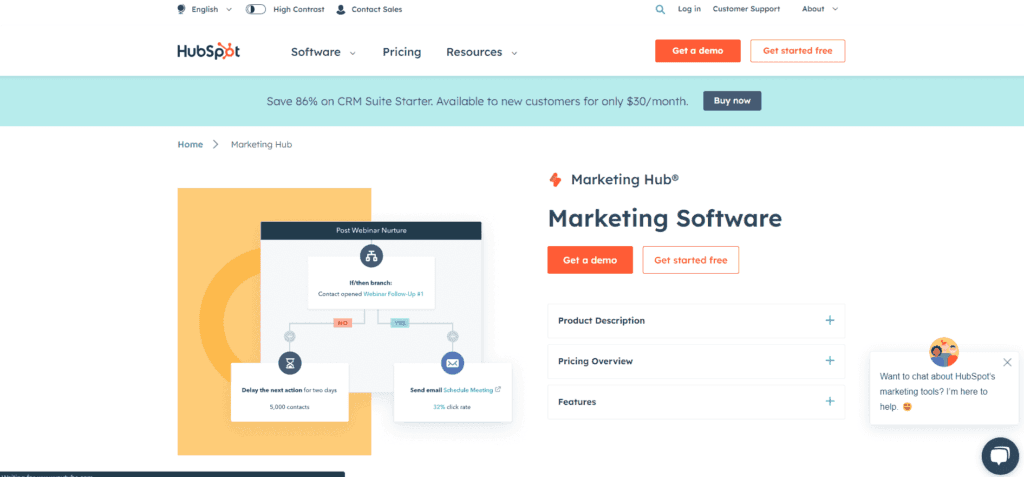
HubSpot’s Marketing Hub utilizes AI to offer insights into user behavior, enabling businesses to tailor content more effectively based on user interactions and preferences.
Features
- Lead Scoring: HubSpot’s AI-powered lead scoring system allows businesses to prioritize potential customers based on their interactions.
- Content Optimization: HubSpot provides suggestions to enhance content for higher engagement.
- Predictive Analytics: Offers forecasts on how certain content will perform based on historical data.
Pricing
Starting at $50 per month for the Starter plan, prices can go up based on the features needed. The Professional and Enterprise versions, packed with more advanced AI features, come at higher costs.
Pros
- Comprehensive all-in-one marketing platform.
- Seamlessly integrates with other HubSpot products.
- Intuitive user interface and ease of use.
Cons
- Can become pricey as you add more features.
- Might be overwhelming for small businesses with simpler needs.
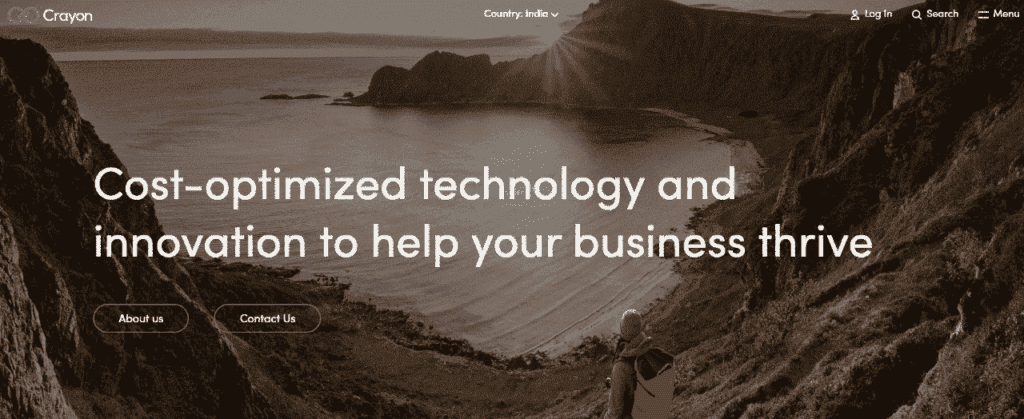
#2. Crayon
Crayon leverages AI to provide insights on the competitive landscape, helping businesses tailor content to stand out.
Features
- Market Landscape Analysis: Provides insights into competitor content and performance.
- Real-time Data: Offers real-time updates on market changes.
- Content Recommendations: Suggests optimizations for content strategy based on AI analysis.
Pricing
Pricing details are provided upon request, depending on the scale and specific needs of the business.
Pros
- Excellent for businesses focusing on competitive differentiation.
- Real-time insights can guide immediate strategy adjustments.
- Integrates with various other marketing tools.
Cons
- Pricing is not transparent.
- Requires a bit of a learning curve for those new to competitive analysis.
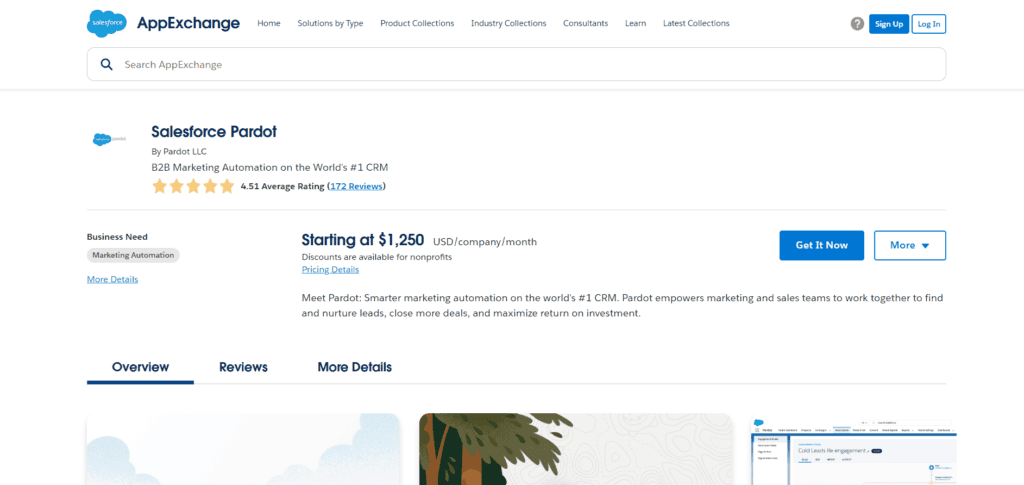
#3. Pardot by Salesforce
Pardot, Salesforce’s B2B marketing automation tool, integrates AI to offer deeper insights into user behavior, helping in content personalization.
Features
- Lead Management: Automated lead tracking and nurturing.
- AI-driven Analytics: Predicts future customer behaviors based on historical data.
- Email Personalization: Crafts personalized emails based on user interactions.
Pricing
Starting at $1,250 per month for the Growth package. Advanced and Premium packages are available at higher costs.
Pros
- High integration capability with Salesforce’s suite of products.
- Robust AI-driven insights.
- Great for B2B businesses.
Cons
- High starting price point.
- Can be complex for smaller businesses.
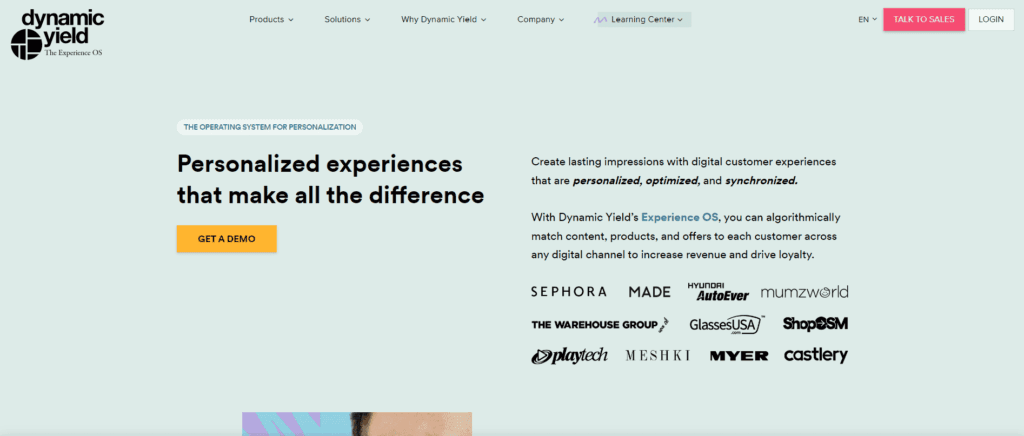
#4. Dynamic Yield
Dynamic Yield offers an AI-powered personalization platform to automate and scale personal content experiences across web, apps, email, and kiosks.
Features
- Personalization Engine: Delivers tailored content based on user behavior.
- Segmentation: Creates user segments for more targeted content delivery.
- Omnichannel Personalization: Consistent personalization across multiple channels.
Pricing
Pricing is based on monthly unique users and is available upon request.
Pros
- Highly scalable for businesses of all sizes.
- Omnichannel consistency ensures uniform user experience.
- Continuous optimization through AI.
Cons
- Lack of transparent pricing.
- Steeper learning curve for those new to content personalization.
#5. OneSpot
OneSpot infuses AI to automate individualization, allowing for tailored content experiences across a user’s journey.
Features
- Individualized Content: Dynamic personalization for every user.
- Cross-channel Capabilities: Delivers consistent experiences across web, email, and ads.
- Insightful Analytics: AI-driven reports on content performance.
Pricing
Pricing details are custom and provided upon request.
Pros
- Focus on individual user journeys.
- High level of automation reduces manual tasks.
- Easily integrates with other marketing tools.
Cons
- Pricing is not upfront.
- Might be overkill for businesses looking for basic personalization.

#6. Albert
Albert is an autonomous digital marketing platform powered by AI, offering businesses insights and automations to optimize their content strategy.
Features
- Autonomous Targeting: Finds optimal audiences for your content.
- Cross-channel Execution: Manages and coordinates campaigns across all channels.
- Real-time Insights: Offers real-time analysis on content performance.
Pricing
Custom pricing based on the scale and needs of the business.
Pros
- High level of automation saves time and effort.
- Coordinates cross-channel campaigns effortlessly.
- Provides quick, actionable insights.
Cons
- More suitable for larger enterprises than small businesses.
- The level of automation might reduce hands-on control for marketers.
Case Study: How Platforms Like Netflix or Amazon Recommend Content/Products to Users
Netflix: A night with Netflix usually starts with a dive into its vast array of recommended shows and movies. But how does Netflix get these recommendations so spot on? The answer lies in its sophisticated AI algorithms.
The platform continually analyzes viewing habits, ratings given by users, and even the time spent watching a particular show. This data is then fed into its recommendation system, which also takes into account global viewing patterns. The result? A curated list of shows and movies that resonate with individual viewing preferences, making the Netflix experience deeply personal.
Personalizing Email Campaigns with AI
The Need for Personalized Email Campaigns in Boosting Open Rates and Engagement
Email remains one of the most effective communication channels for businesses. Yet, generic, one-size-fits-all email campaigns are no longer sufficient. Users crave personalized experiences, and emails that cater to individual preferences and behaviors see significantly higher open and engagement rates.
For businesses, this personal touch can make the difference between a successful campaign and one that sinks without trace. It’s not just about addressing the user by their first name; it’s about delivering content that resonates, offers that appeal, and messages that motivate action.
AI Tools That Aid in Segmenting Email Lists and Crafting Tailored Messages
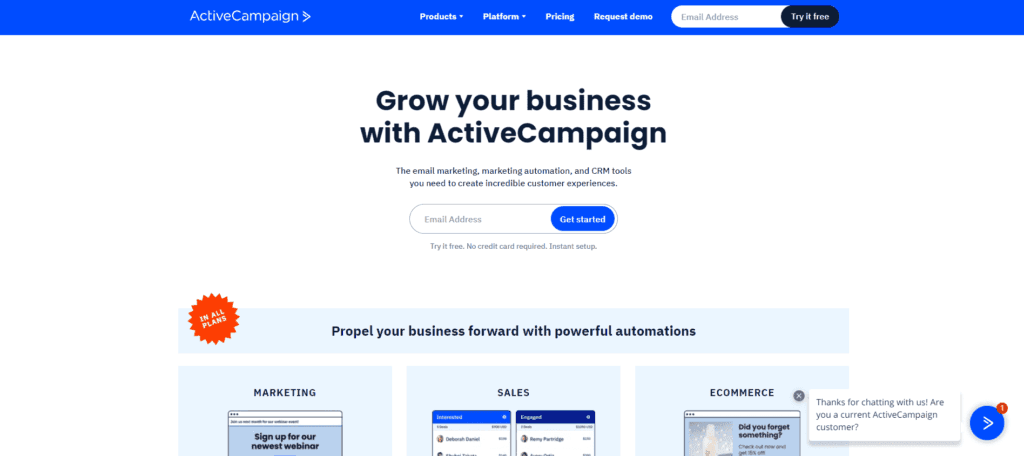
#1. ActiveCampaign
ActiveCampaign uses machine learning to help businesses craft personalized email campaigns based on user behavior and engagement patterns.
Features
- Predictive Sending: Uses AI to send emails at the optimal time for each contact.
- Segmentation: Dynamic list segmentation based on user interactions.
- Content Personalization: AI-driven recommendations for content tailored to each user.
Pricing
Starts at $9 per month for the Lite plan. More advanced features are available in Plus, Professional, and Enterprise tiers at higher prices.
Pros
- Combines email marketing, automation, and CRM.
- Intuitive drag-and-drop email designer.
- Extensive integrations with third-party platforms.
Cons
- The learning curve for advanced features.
- Costs can accumulate as more contacts are added.
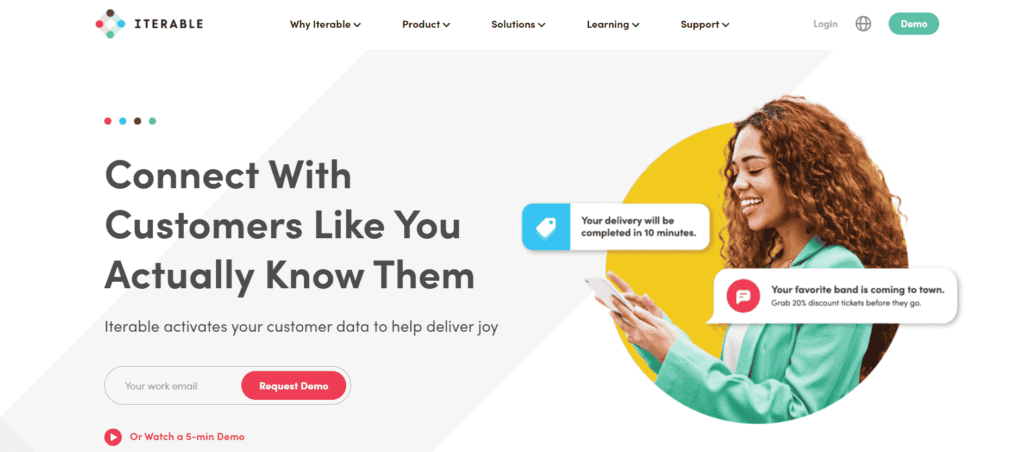
#2. Iterable
Iterable empowers marketers to segment audiences and craft tailored email campaigns using AI-driven insights.
Features
- Dynamic Segmentation: AI-powered list management based on user behavior.
- Workflow Automation: Uses AI to optimize email campaign flows.
- Optimized Send Times: Predicts best sending times for individual users.
Pricing
Custom pricing based on the number of contacts and specific business needs.
Pros
- Multi-channel marketing platform.
- Advanced user insights for targeted campaigns.
- Seamless integrations with major platforms.
Cons
- No upfront pricing available.
- May be overwhelming for small businesses.

#3. Moosend
Moosend provides AI-enhanced email marketing solutions, helping businesses send more personalized and effective emails.
Features
- Predictive Analytics: Forecasts user behavior and email interactions.
- AI-driven Recommendations: Tailors content suggestions for emails.
- Automated List Management: AI-enhanced segmentations.
Pricing
Offers a free plan. Paid plans start at $8 per month based on the number of subscribers.
Pros
- User-friendly interface.
- Affordable plans, including a free tier.
- Advanced tracking and analytics tools.
Cons
- Limited integrations compared to competitors.
- Advanced features require higher-tier plans.
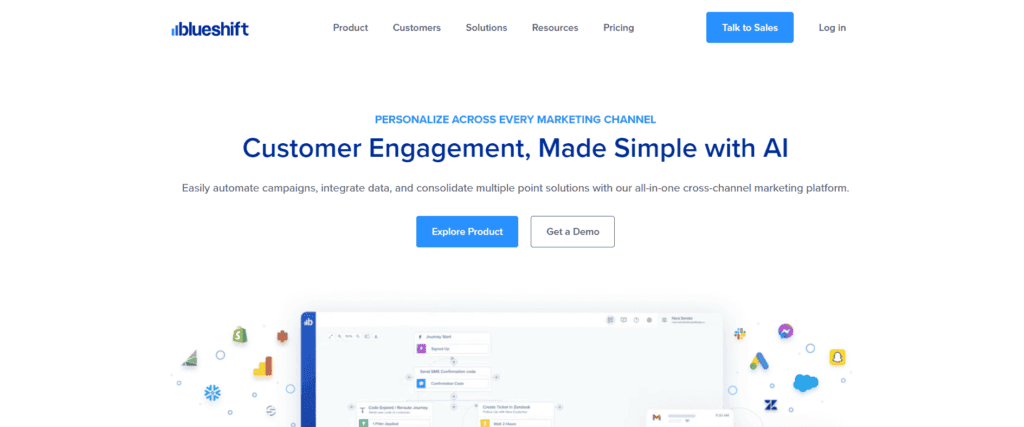
#4. Blueshift
Blueshift’s AI-powered email marketing allows businesses to send personalized, real-time messages that resonate with individual recipients.
Features
- Behavioral Segmentation: Uses AI to categorize users based on actions.
- AI-Driven Triggers: Sends emails based on real-time user behavior.
- Content Recommendations: Personalizes email content for higher engagement.
Pricing
Custom pricing based on business needs and scale.
Pros
- Omnichannel marketing capabilities.
- Real-time personalization features.
- Integrates with a wide range of platforms.
Cons
- Pricing isn’t transparent.
- Might be complex for email marketing beginners.

#5. Optimizely
While widely known for web experimentation, Optimizely also offers AI-enhanced email personalization to drive engagement.
Features
- Dynamic Content: Adapts email content in real-time.
- Segment Discovery: Uses AI to uncover potential audience segments.
- Adaptive Audiences: AI-driven user categorization for targeted campaigns.
Pricing
Custom pricing based on features and scale.
Pros
- Extends personalization beyond emails.
- Advanced experimentation capabilities.
- Robust analytics and insights.
Cons
- Steep learning curve.
- Cost can be on the higher side for smaller businesses.
SendinBlue offers an AI-powered email marketing solution to help businesses automate and personalize their email campaigns.
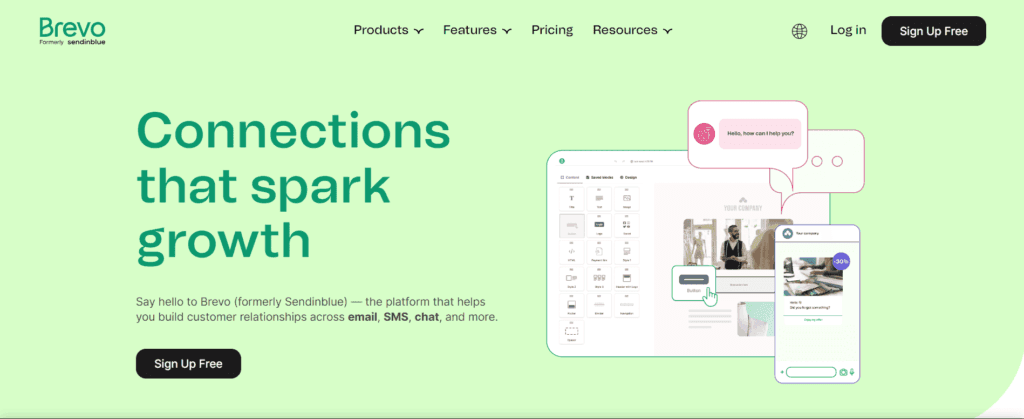
#6. SendinBlue
Features
- AI-Driven Send Time Optimization: Predicts the best time to send emails to each contact.
- Machine Learning Segmentation: Tailors lists based on user behavior.
- Dynamic Email Content: Adapts content to fit individual user profiles.
Pricing
Free plan available. Paid plans start at $25 per month.
Pros
- All-in-one platform for email, SMS, and chat.
- User-friendly with drag-and-drop features.
- Transparent and scalable pricing.
Cons
- Limited advanced analytics in lower-tier plans.
- Sending limits on some plans.
Tactics for AI-Driven Dynamic Content Placement Within Emails
Behavioral Triggering: Deploying content based on a user’s past interactions. For example, if they browsed a specific product but didn’t purchase, an email might highlight that product with a special offer.
Real-time Personalization: Using AI to alter email content based on real-time data, such as current sales or stock levels.
Predictive Recommendations: Inserting product or content recommendations within the email based on predictive analytics.
Enhancing User Experience with AI Chatbots
The Growing Role of Chatbots in Enhancing User Experience on Websites
The digital age is all about immediacy. Today’s users expect quick and relevant responses to their queries, regardless of the time of day. Enter AI-powered chatbots, the tireless customer support representatives that never sleep.
For startup founders and C-level executives, integrating AI-driven chatbots into their platforms can be a game-changer. These chatbots not only ensure round-the-clock customer interaction but also significantly reduce the load on human support teams, leading to cost savings and enhanced user satisfaction.
How AI-Driven Chatbots Provide Tailored Content Responses to User Queries
At their core, modern chatbots leverage Natural Language Processing (NLP) and machine learning algorithms to understand user intent. This isn’t about following a fixed script. Instead, AI chatbots learn from each interaction, making them more adept at handling varied user queries over time.
For instance, a user might ask an e-commerce chatbot, “Do you have any summer dresses on sale?” The AI chatbot, understanding the user’s intent, could provide personalized product recommendations based on the user’s browsing history or popular items.
Strategies to Integrate Personalized Content into Chatbot Interactions
User Profile Analysis: By examining a user’s profile, preferences, and past interactions, chatbots can provide tailored product suggestions or support.
Real-time Data Integration: If integrated with real-time inventory systems, chatbots can provide up-to-the-minute product availability or service updates.
Feedback Loop: Continuously refining chatbot responses based on user feedback ensures that the AI evolves and becomes more effective over time.
AI in Personalizing Video Content
The Importance of Video Content in Current Digital Marketing Strategies
The adage “a picture is worth a thousand words” has evolved in the digital age to “a video is worth a million.” Video content, with its ability to convey complex messages succinctly and engagingly, has become a cornerstone of digital marketing. As users’ attention spans wane, videos provide a quick, immersive way to capture their interest.
Yet, just as with written content, personalization is key. Generic video content, no matter how well produced, can’t match the engagement levels of tailored, user-specific videos.
Tools and Platforms That Utilize AI for Video Content Personalization

#1. Magisto
Magisto is a cloud-based platform that leverages AI to assist businesses in creating and editing personalized video content.
Features
- Smart Video Editor: AI-driven editing to craft compelling narratives.
- Audience Analysis: Uses AI to gauge viewer preferences and optimize content.
- Custom Branding: Ability to integrate logos, brand colors, and more.
Pricing
Starts at $4.99 per month for the Premium plan. Professional and Business plans available at higher costs.
Pros
- Intuitive interface suitable for non-editors.
- Efficient video creation and editing process.
- Offers stock footage and music library.
Cons
- Limited advanced editing tools.
- Premium music tracks may incur additional costs.

#2. Promo.com
Promo.com offers AI-driven tools to create personalized video ads, ensuring relevant content delivery to the target audience.
Features
- AI Video Creation: Personalized video ads based on user preferences.
- Video Templates: Wide range of customizable templates.
- Collaboration Tools: Team collaboration in real-time.
Pricing
Basic plan starts at $39 per month. Standard, Pro, and Enterprise plans available at varied prices.
Pros
- Easy to use with drag-and-drop features.
- Extensive media library for creative flexibility.
- In-depth analytics to measure video performance.
Cons
- Higher resolution videos cost more.
- Limited AI capabilities in the basic plan.
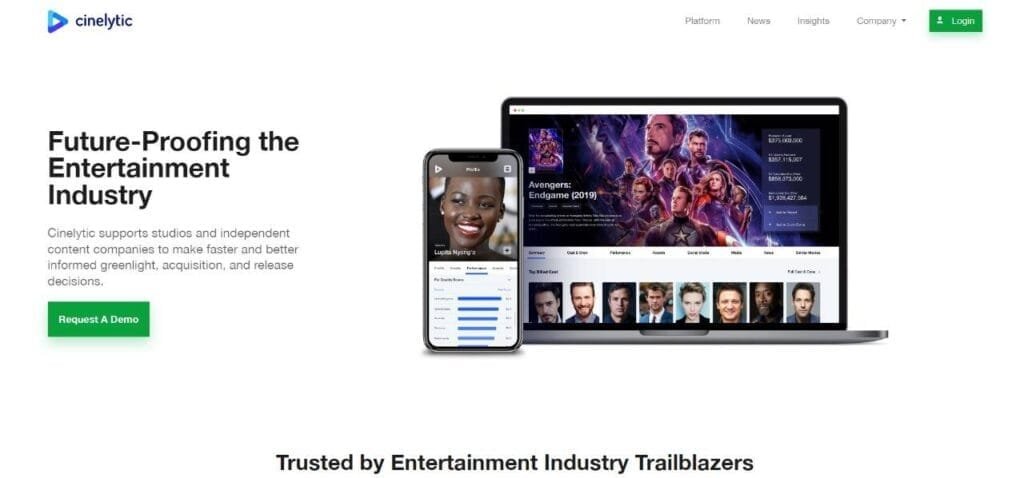
#3. Cinelytic
Cinelytic is an advanced AI-driven platform designed for the entertainment industry to predict audience preferences and personalize video content.
Features
- Predictive Analytics: Forecasts audience reactions to different content.
- Content Insights: AI-driven analysis of scripts and scenes.
- Talent Evaluation: Evaluates the potential draw of actors and directors.
Pricing
Custom pricing based on specific business needs.
Pros
- Tailored for the film and entertainment industry.
- Deep insights for production decisions.
- Collaborative workspace for teams.
Cons
- Higher cost barrier for small productions.
- Niche focus limits broader application.
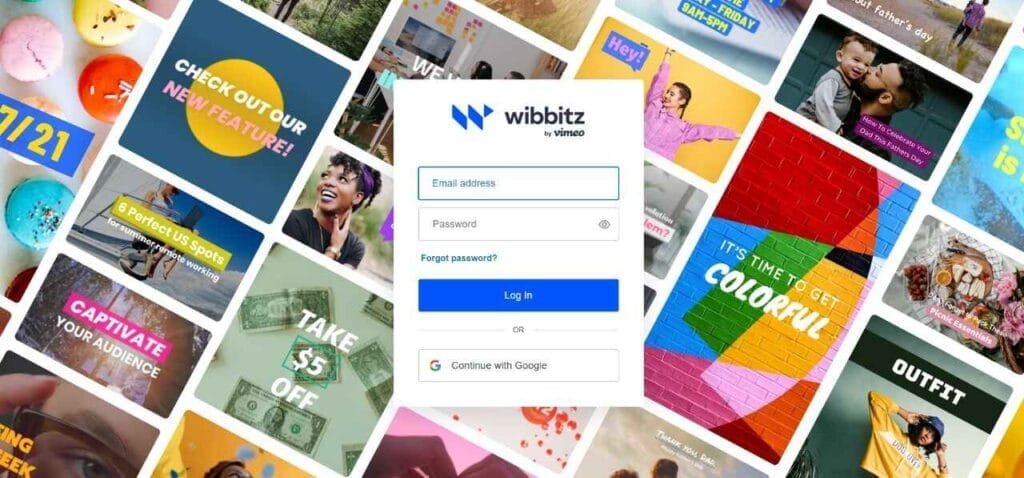
#4. Wibbitz
Wibbitz is an AI-powered video creation platform that aids businesses in crafting content aligned with user preferences.
Features
- Automated Video Creation: Transforms articles into engaging videos.
- Customizable Templates: Wide range for various content types.
- Performance Tracking: AI-driven insights to gauge video impact.
Pricing
Custom pricing based on functionalities and scale.
Pros
- Streamlines video production process.
- Allows voiceover integrations.
- Provides stock media resources.
Cons
- Pricing is not transparent.
- Might require training for advanced features.
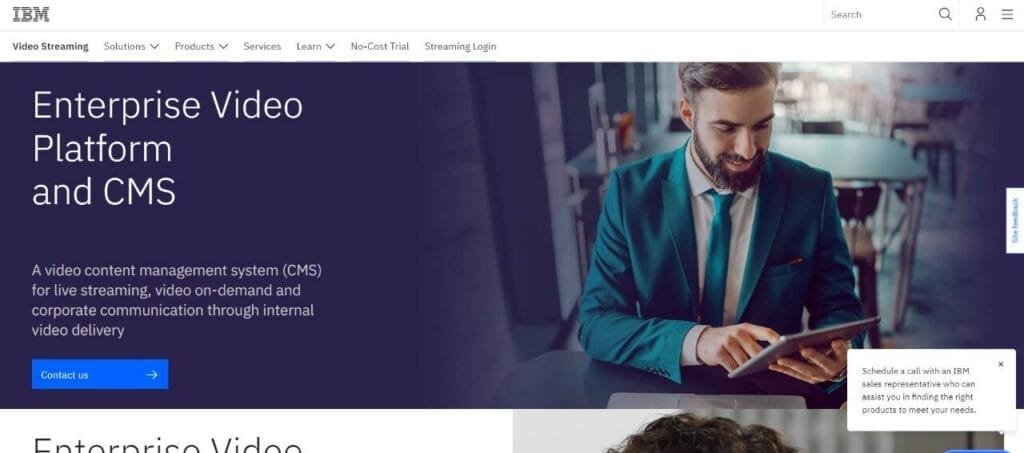
#5. IBM Watson Media
IBM Watson Media uses AI to analyze video content, providing actionable insights to ensure content resonates with the intended audience.
Features
- AI-Driven Analytics: Evaluates viewer engagement and preferences.
- Automated Closed Captioning: Uses AI for accurate transcriptions.
- Content Search: Advanced AI-driven video search functionalities.
Pricing
Custom pricing based on requirements and scale.
Pros
- Robust AI capabilities backed by IBM’s technology.
- Enhances video accessibility.
- Real-time streaming analytics.
Cons
- Complex for beginners.
- Pricing can be on the higher side for startups.
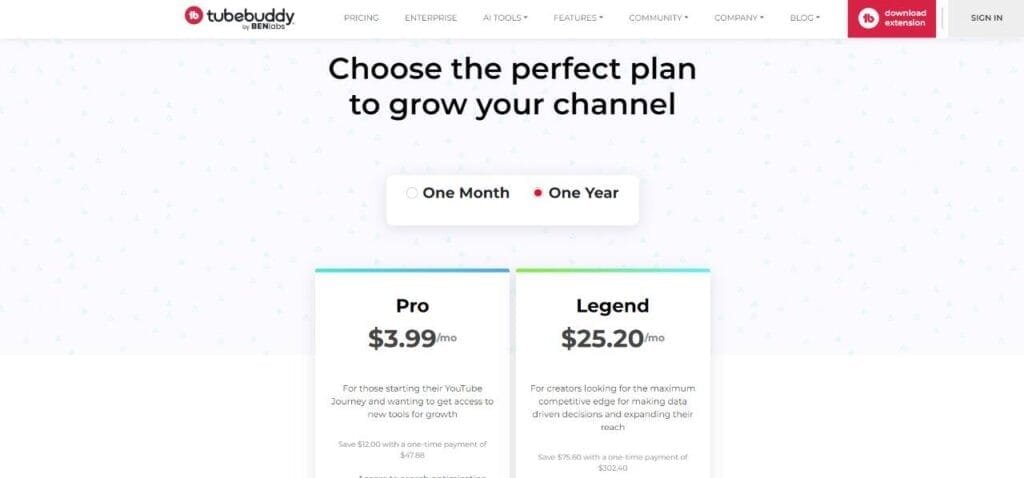
#6. TubeBuddy
Designed for YouTube creators, TubeBuddy integrates AI tools to optimize video content for better reach and engagement.
Features
- Keyword Explorer: AI-driven keyword suggestions for better SEO.
- A/B Testing: Tests video thumbnails and titles for optimal engagement.
- Video Optimization: AI suggestions to enhance content quality.
Pricing
Starts at $9 per month for the Pro version. Star and Legend versions available at higher prices.
Pros
- Integrated directly with YouTube.
- Comprehensive toolkit for channel growth.
- Transparent and affordable pricing.
Cons
- Limited to YouTube platform.
- Some features are platform-dependent.
Tactics for Embedding Personalized Elements within Videos
Dynamic Content Insertion: Imagine a video where the product being advertised changes based on the viewer’s past purchase history or browsing behavior.
Personalized Call-to-Actions (CTAs): Instead of a generic “Learn More,” the video might end with “Hey [User’s Name], Try It Out!”
User-driven Story Paths: Letting users choose their adventure, where the video’s narrative changes based on their choices, ensuring a unique experience for every viewer.
Personalizing Ads with AI for Higher Conversion
The Transformation of Ad Targeting and Retargeting with AI
Ads play a crucial role in the online ecosystem. Every startup founder and C-level executive knows the importance of ads in increasing brand visibility and driving conversions. But the days of broad, non-specific ad campaigns are fading. In the age of data-driven decisions, AI steps in to ensure that ads are tailored to resonate with the right audience at the right time.
AI transforms ad targeting by analyzing vast amounts of user data – from browsing history to purchase behavior, to social media activity. This data is then processed to create user profiles and segment audiences, ensuring that every ad is personalized and relevant.
Platforms That Allow for AI-Driven Ad Personalization
AdRoll: This platform uses AI to understand user behavior, allowing businesses to retarget their audience effectively. With advanced machine learning, AdRoll provides insights into which ads are performing best, facilitating ongoing optimization.
Criteo: Known for its dynamic retargeting solutions, Criteo uses AI to analyze user behavior and predict which product a user is likely to purchase. By serving ads tailored to these predictions, businesses see a boost in conversions.
Strategies for Crafting Ads That Resonate with Individual User Preferences
Behavioral Triggers: By analyzing actions like abandoned carts or viewed products, AI can serve ads that remind users of their past behaviors, nudging them towards a conversion.
Dynamic Content Creation: Instead of static ads, AI can create ads on-the-fly, adjusting elements like images, text, or colors based on the user’s profile.
Optimized Ad Spend: AI tools can predict which ad placements and platforms will yield the highest ROI, ensuring that every advertising dollar is well-spent.
Measuring the Impact of AI-Personalized Content
Importance of Tracking the Performance of Personalized Content
As with any business initiative, tracking and measuring the performance of personalized content is pivotal. After all, it’s not just about delivering tailored content – it’s about understanding its impact on engagement, retention, and conversion rates. AI-driven personalization is not a set-it-and-forget-it strategy; it’s a dynamic process that requires constant monitoring and iteration.
AI Tools That Assist in Content Performance Analytics
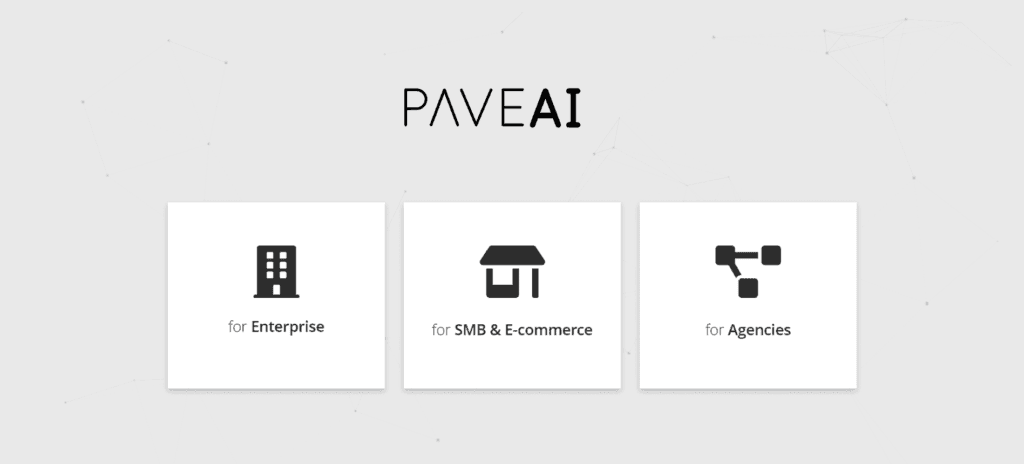
#1. PaveAI
PaveAI is an analytics tool that turns raw Google Analytics data into actionable insights using its AI-driven algorithms.
Features
- Automated Reports: Generates clear, comprehensive reports from analytics data.
- Segment Analysis: AI identifies significant trends across user segments.
- Custom Integrations: Seamless integration with platforms like Google Ads and Facebook Ads.
Pricing
Pricing starts from $49 per month for the Starter plan. Professional and Enterprise plans are available at higher tiers.
Pros
- Eliminates manual data interpretation tasks.
- Offers actionable recommendations.
- Simplifies complex data sets.
Cons
- Limited to Google Analytics data for base package.
- Advanced integrations require higher-tier plans.
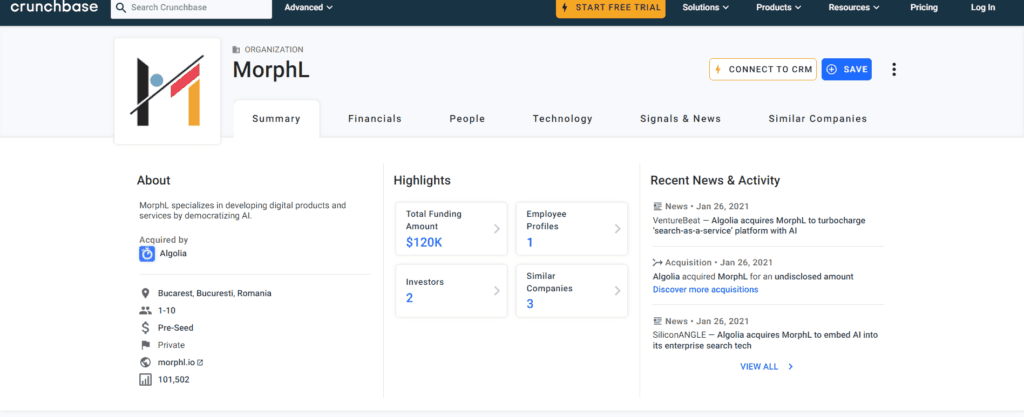
#2. MorphL
MorphL uses AI to predict user behaviors, aiming to optimize user experiences and boost conversions.
Features
- User Predictions: Anticipates future actions of users.
- Churn Prediction: Forecasts potential subscriber or customer losses.
- Custom AI Models: Allows businesses to craft models specific to their needs.
Pricing
They offer a freemium model with basic features. Paid plans start from $499 per month.
Pros
- Versatile in predicting various user behaviors.
- Easy to integrate with existing platforms.
- Open-source options available.
Cons
- The learning curve for custom AI models.
- Higher-tier pricing can be restrictive for smaller businesses.
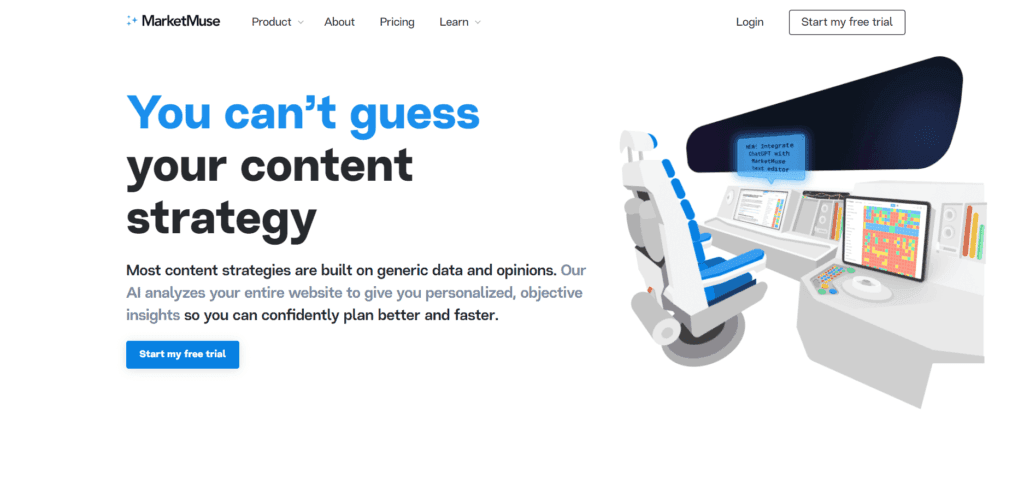
3. MarketMuse
MarketMuse applies AI to dissect content quality, offering insights to improve content relevance and performance.
Features
- Content Inventory: In-depth analysis of existing content.
- Research Assistant: AI-driven content topic suggestions.
- Performance Tracking: Monitors content impact over time.
Pricing
Plans start from $1,500 per month. Custom Enterprise plans are also available.
Pros
- Comprehensive content analysis suite.
- Streamlines content planning and optimization.
- Scalable to accommodate large content repositories.
Cons
- Pricing may be steep for small businesses.
- Requires dedicated time for platform mastery.
#4. Oribi
Oribi simplifies the process of understanding analytics by offering insights without the need for manual setup or tagging.
Features
- Event Tracking: Automated tracking without manual tags.
- Conversion Analysis: AI insights into optimizing conversion paths.
- Individual Visitor Journeys: Detailed paths of individual users.
Pricing
Business plans start at $450 per month. Custom pricing for Enterprise solutions.
Pros
- User-friendly interface.
- No manual tagging or coding required.
- Integrates with numerous marketing platforms.
Cons
- Advanced features necessitate higher pricing tiers.
- Limited historical data on the base plan.
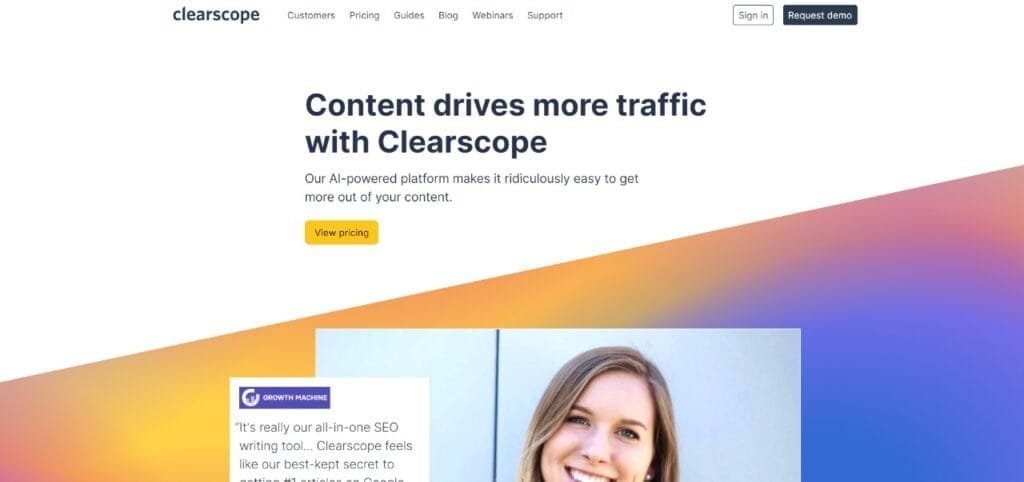
#5. Clearscope
Clearscope focuses on content optimization for SEO. It employs AI to evaluate content against top-performing search results.
Features
- Competitive Analysis: Compares content against top search results.
- Content Grading: Rates content on relevance and comprehensiveness.
- Keyword Recommendations: AI-driven keyword suggestions.
Pricing
The Basic plan is priced at $350 per month, with more advanced plans available.
Pros
- Direct focus on SEO content optimization.
- Comprehensive content reports.
- Simple integration into content workflows.
Cons
- Niche focus may not suit all businesses.
- Pricing might be out of reach for solo content creators.
#6. Cortex
Cortex aims to enhance content performance by predicting how audiences will perceive content before it’s published.
Features
- Image Recommendations: Suggests visuals based on audience preferences.
- Content Calendar: AI-driven content scheduling for optimal impact.
- Performance Forecasts: Predicts content success metrics.
Pricing
Custom pricing based on the needs and scale of the organization.
Pros
- Advanced visual content analysis.
- Seamlessly integrates with social platforms.
- Continuous learning model improves over time.
Cons
- Absence of transparent pricing.
- May require training for full feature utilization.
Analyzing Metrics to Refine and Improve Personalization Strategies
Engagement Metrics: Look at metrics like time spent on page or click-through rates to understand how users interact with personalized content.
Conversion Rates: Ultimately, personalization should drive action. Whether it’s signing up for a newsletter or making a purchase, tracking conversion rates is crucial.
Feedback and Surveys: AI can aggregate and analyze user feedback to refine personalization algorithms further.
Ethical Considerations and User Privacy
Addressing Concerns About User Data and AI
As we delve deeper into the world of AI-driven content personalization, one glaring concern that surfaces is user privacy. With daily reports of data breaches and concerns about data misuse, ensuring user trust becomes paramount.
For businesses, it’s not just about collecting data but ensuring its ethical use. This entails transparency in data collection, understanding where and how data is stored, and providing users with the autonomy to manage their data. By being upfront about data collection practices, businesses can foster trust and ensure a positive user experience.
Strategies for Transparent Data Collection and Usage
Clear Communication: It’s essential for businesses to clearly communicate to users what data is being collected, why it’s being collected, and how it will be used. This might include user-friendly privacy policies or pop-ups that explain data collection in layman’s terms.
Opt-in and Opt-out Options: Give users control. Before collecting data, especially for personalization, provide users with the option to opt-in. Equally, if they change their mind, an easy opt-out process should be available.
Regular Data Audits: Regularly audit the data you hold. Understand what’s necessary and what’s redundant. Delete data that isn’t required, reducing potential risks.
Ensuring Compliance with Data Protection Regulations
With regulations like GDPR in Europe and CCPA in California, businesses need to be aware of regional data protection laws. These laws have been enacted to protect user data and ensure businesses handle it responsibly.
Stay Updated: Laws and regulations evolve. It’s crucial to stay updated and ensure that your data practices comply with the latest regulations.
Implement Strong Security Measures: Use encryption, two-factor authentication, and other security measures to safeguard user data.
Transparent Reporting: In the event of a data breach, communicate transparently with affected users and take immediate actions to remedy the situation.
Overcoming Challenges in AI-Personalized Content
Common Challenges in Implementing AI-Driven Personalization
While AI offers a plethora of advantages in content personalization, it’s not without its challenges. From data quality to user skepticism, businesses often grapple with various issues when implementing AI-driven strategies.
Data Quality: AI and machine learning models are only as good as the data fed into them. Inaccurate or biased data can lead to misinformed content strategies.
Integration with Existing Systems: For many businesses, integrating AI tools with existing content management systems or CRM platforms can be daunting.
User Skepticism: Often, users can be skeptical of AI-driven content, feeling it’s too intrusive or lacks a human touch.
Solutions and Strategies to Address These Challenges
Invest in Data Hygiene: Regularly clean and update your data repositories. This ensures that your AI models are working with the most accurate and relevant information.
Collaboration with IT Teams: A close collaboration between content and IT teams can streamline the integration process and ensure that AI tools are implemented efficiently.
Blending AI with Human Insight: While AI can offer data-driven insights, it’s essential to blend these with human intuition and creativity. This ensures that content remains relatable and authentic.
The Future: What’s Next in AI and Content Personalization?
Predictive Insights into the Evolving Landscape of AI in Content
In the ever-evolving realm of technology, predicting the exact trajectory of AI and its role in content personalization is a complex task. However, certain trends indicate where the industry might be heading. Enhanced machine learning algorithms, the growth of neural networks, and innovations like quantum computing are poised to supercharge the capabilities of AI in content personalization. This will allow for even more granular personalization, taking into account subtle nuances of individual user behaviors, preferences, and real-time reactions.
Emerging Technologies and Tools on the Horizon
- Generative Adversarial Networks (GANs): These neural network architectures have shown incredible promise in generating content. From crafting realistic images to simulating text, the potential applications of GANs in content creation are immense.
- Quantum Computing: As quantum computers become more mainstream, their unparalleled processing power could lead to AI models that can analyze vast amounts of data in fractions of a second, delivering hyper-personalized content in real-time.
- Augmented Reality (AR) and Virtual Reality (VR): With the integration of AR and VR, personalized content won’t just be about what’s on the screen. Businesses can create immersive, tailored experiences for users that are unparalleled in their depth and interactivity.
How Businesses Can Prepare for the Next Wave of AI-Driven Personalization
- Continuous Learning: The tech landscape is always in flux. By investing in continuous learning and upskilling, businesses can stay ahead of the curve, ensuring they’re always ready to leverage the latest AI advancements.
- Data Management: As AI capabilities grow, so will the importance of data. Firms should refine their data collection, storage, and analysis strategies to ensure they’re equipped to handle the influx of insights AI will bring.
- Ethical AI Practices: As AI tools become more powerful, ethical considerations will come to the forefront. It’s essential for businesses to lay down strong ethical foundations now, ensuring they can navigate the future responsibly.
Wrapping It Up
The fusion of AI and content personalization heralds an exciting era for businesses and consumers alike. While AI provides the tools to craft hyper-personalized user experiences, it’s up to businesses to wield these tools responsibly and creatively. The future landscape will be characterized by a blend of innovation, ethics, and a constant drive to deliver value to the end-user. As we navigate this promising horizon, continuous learning, adaptation, and a user-first mindset will be the guiding stars leading the way.
Read Next:
- Measuring SEO ROI: Analytics and Metrics You Should Track
- How to Create a SMART Plan: The Complete Guide
- Why Internal Linking is So Important for SEO
- 23+ Ultimate Customer Support Tools to Empower Your Business
- 15+ Best Digital Asset Management Software to Transform Your Workflow






















Comments are closed.